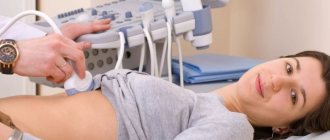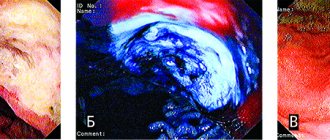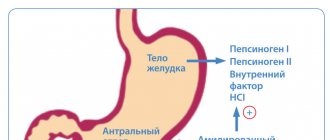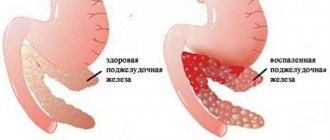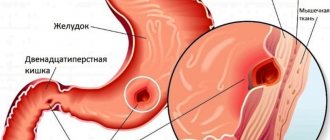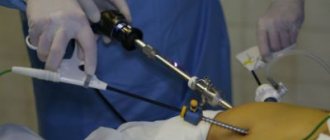Despite a significant reduction in elective surgery for gastric and duodenal ulcers, the incidence of complicated peptic ulcers remains high. The most common cause of emergency surgical interventions for peptic ulcer disease is a perforated ulcer, the most serious complication of this disease, accompanied by high mortality, reaching from 6 to 30% [1]. A perforated ulcer is the cause of death in 60–70% of patients with peptic ulcer disease [1, 2].
Laparoscopic suturing of a perforated ulcer has shown its effectiveness from the first stages of implementation. The simplicity of this operation quickly found its supporters [3]. The data published to date on the reduction in the incidence of complications, mortality and reduction in treatment time have convinced us of the need for its introduction into widespread clinical practice. A.S. Ermolov, commenting on an article on perforated ulcers, cited his own data from 300 video-endoscopic suturing of perforated ulcers without deaths. He noted that only gradual mastery of these operations in 90% of cases can lead to a high clinical effect [4].
Accelerated rehabilitation Fast Track after surgical interventions is an actively developing area in planned surgery [5, 6]. At the same time, in emergency surgery this technique encounters many opponents. In both domestic and foreign literature, reports on the use of an accelerated rehabilitation protocol for various emergency surgical diseases and trauma are few [7–10].
The purpose of the work is to study the results of using an accelerated rehabilitation program in patients with a perforated duodenal ulcer.
Material and methods
The introduction of laparoscopic suturing of a perforated ulcer and the method of accelerated rehabilitation began to be used in the clinic in 2013.
This paper presents the results of treatment of 206 patients with perforated duodenal ulcer, carried out at the clinical base of the Department of Surgery and Endoscopy, Faculty of Additional Professional Education, Federal State Budgetary Educational Institution of Higher Education Russian National Research Medical University named after. N.I. Pirogov from 2013 to 2016. The main group included 77 patients. The criteria for inclusion in the main group of accelerated rehabilitation were localization of the ulcer in the duodenum, the diameter of the perforation hole less than 1 cm, laparoscopic suturing of the perforated ulcer, and implementation of the accelerated rehabilitation protocol. The control group consisted of 129 patients who underwent open suturing of a perforated ulcer (see table),
Results of treatment of patients with perforated gastric and duodenal ulcers for 2013–2016. and in the postoperative period traditional treatment was carried out. The age of patients in the control group ranged from 47 to 88 years (average - 54 years), the main group - from 19 to 68 years (average - 42 years). In the control group, the time of hospitalization of patients from the onset of symptoms of the disease ranged from 2 to 24 hours, in the main group - from 40 minutes to 12 hours. Patients who at the time of admission had a pronounced clinical picture of widespread peritonitis and the presence of a perforated gastric ulcer were excluded from the study . All patients were operated on no later than 2 hours from the moment of hospitalization. The complex of preoperative examinations in both groups was the same and included a standard set of laboratory tests upon admission and plain radiography of the abdominal organs. If there were signs of free gas in the abdominal cavity, the diagnosis of perforation of a hollow organ was considered confirmed, on the basis of which the patients were sent to the operating room. All patients with a clinical picture of perforation of a hollow organ underwent esophagogastroduodenoscopy (EGDS). In the absence of signs of free gas on plain radiography, endoscopy was performed at the admission stage. In the presence of free gas in the abdominal cavity, endoscopy was performed on the operating table after the patient was put under anesthesia: this is necessary to exclude combined complications of peptic ulcer disease and to clarify the location and size of the ulcerative defect.
results
In the control group of 129 patients, 101 (78.3%) had a perforated ulcer sutured, usually with a double-row suture with an absorbable braided thread. In 28 (21.7%) patients, the Oppel-Polikarpov suturing method was used with tamponade of perforation with a strand of the greater omentum. The operation was completed by sanitation of the abdominal cavity and its drainage, usually 2 drainages. In the main group, 72 (93.5%) patients underwent suturing of the ulcer with an intracorporeal “sliding” interrupted single-row suture with a 2/0 absorbable braided thread. In 5 (6.5%) patients of the main group, a method of suturing the perforation hole was used with strengthening the greater omentum with a strand. The dimensions of the perforations in the control group were 0.7–1.5 cm, in the main group – 0.5–1.0 cm. During laparoscopic interventions, sanitation of the abdominal cavity was performed by aspiration of the leaked gastroduodenal contents without irrigation. Drainage of the abdominal cavity was performed in 32 (41.6%) patients with one drainage. In the control group, the drainage was removed on days 2–5 of the postoperative period. In the main group, if drainage was present, it was removed on the 1st day of the postoperative period.
In the control group, traditional management of the postoperative period was carried out: nasogastric intubation until resolution of intestinal paresis, activation of patients on days 2–3 after surgery, fluid intake starting from the 3rd day after surgery, oral nutrition from the 4th day. At the end of the operation, 61 (47.3%) patients were transferred to the intensive care unit, where therapy was carried out for 1 day. There were no postoperative surgical complications in the control group. The mortality rate was 2.3% (3 patients died). The causes of death were cardiopulmonary complications and pulmonary embolism (PE). The average length of stay of patients in the hospital during the postoperative period was 8.1 days.
The accelerated rehabilitation protocol included transfer of patients to the surgical department immediately after surgery; the nasogastric tube was removed at the end of surgery, the catheter from the bladder - 2 hours after surgery; patients were activated within 2 to 5 hours after surgery. Fluid intake began on the 1st day of the postoperative period, oral nutrition - from the 2nd day. The drainage from the abdominal cavity was removed the next day after surgery. A postoperative complication occurred in 1 (1.3%) case - failure of the sutures on the sutured perforation. The cause of the complication was the underestimation of infiltrative changes around the ulcer and the size of the perforation hole. The patient was re-operated on the 2nd day after surgery, open suturing of the perforation hole was performed according to Oppel-Polikarpov. There were no deaths in the main group, and the average length of stay of patients in the hospital was 4.8 days.
Patients in both groups received antiulcer therapy with proton pump blockers (esomeprazole, pantoprazole) in the first hours of the postoperative period. Within 2 days after surgery, all patients were treated with injectable forms of proton pump inhibitors; subsequently, the patients were transferred to oral administration of the drugs.
Introduction
Over the past 15 years, drug therapy has been a priority in the treatment of gastric ulcer (GPU) and duodenal ulcer (DU). The development and improvement of surgical interventions for peptic ulcers and peptic ulcers has sharply slowed down due to the successful complex use of H2 receptor antagonists, proton pump inhibitors (PPIs), and anti-Helicobacter therapy. This revolutionary step in therapy has led to the fact that the need for elective surgical treatment of uncomplicated peptic ulcer disease has been minimized. As a rule, gastric resection is used for complicated course of ulcerative gastric ulcer and peptic ulcer. At the same time, drug treatment did not completely eliminate relapses of gastric ulcers and ulcers and recurrent bleeding [2, 4]. In this regard, the number of complications of peptic ulcer disease, such as perforation, bleeding, stenosis, and penetration, does not decrease. All these complications of peptic ulcer disease require surgical treatment.
A serious argument in limiting the indications for planned surgical treatment of peptic ulcer disease was the high traumatic nature of open surgical access, a significant number of immediate and late postoperative complications, long treatment periods and disability after open gastrectomy (ORG). All these shortcomings were eliminated as the technique of laparoscopic gastrectomy (LGR) improved.
The emergence of laparoscopic technologies in surgery made it possible to develop and introduce into surgical practice LRZ for peptic ulcer disease.
In February 1992, P. Goh and C. Kum [7] performed successful laparoscopic resection of ⅔ of the stomach according to Billroth II. It would seem that a new direction in the surgery of peptic ulcers and peptic ulcers will be widely promoted by surgeons. Indeed, in Russia the first laparoscopic gastric resections took place in 1994-1995. completed O.E. Lutsevich [3], V.P. Sazhin [5] and V.N. Egiev [1]. By 2000, the experience of performing LRZ for peptic ulcer disease had grown and crossed the line of 70 operations. However, from 2000 to the present, the total number of LRGs performed for gastric and duodenal ulcers in Russia is unknown.
It should be recognized that laparoscopic operations on the stomach have not become widespread to this day. However, this trend is also typical for other abdominal diseases. According to A.V. Fedorov and V.E. Olovyanny (2011), “...no more than 30% of general surgeons use the laparoscopic method. Among all interventions on the abdominal organs, laparoscopic operations account for about 20%” [6].
In 2010-2012 Surgical websites on the Internet demonstrate successful options for performing laparoscopic gastrectomy for gastric ulcers and peptic ulcers, but in the medical literature there are no results of generalized and systematic studies on this problem.
The purpose of the study is to conduct a comparative assessment of the results of open and laparoscopic gastric resections for complicated gastric and duodenal ulcers.
Material and methods
In the period from 1994 to 2012, we performed laparoscopic gastrectomy in 84 patients with a complicated course of gastric ulcer and peptic ulcer. All surgical interventions were performed using the Billroth-II technique modified by Dubourg. The results of LRZ were compared with the results of treatment of 99 patients who underwent LR. The structure of diseases during laparoscopic and open gastrectomy is presented in Table. 1
.
In both groups, patients with existing ulcerative gastroduodenal bleeding (UGDB) predominated.
In case of PU, LRZ was performed in 58.3% of patients, in case of DU - 41.7% of patients. Approximately the same ratios were in the group of patients who underwent ORG - 56.6 and 43.4%, respectively. Both groups are comparable in age (the average age of patients was 58.3±3.7 years) and gender (men predominated 77.6±1.1%). They had various concomitant diseases. Gastric ulcers were localized mainly in the body of the stomach, on the lesser curvature (75.4%). The size of the ulcers ranged from 0.8 to 3 cm (average 1.9±0.5 cm). The depth of the ulcers ranged from 0.6 to 1.1 cm (average 0.9±0.3 cm). Duodenal ulcers were localized mainly on the posterior wall (62.7%). The size of duodenal ulcers averaged 1.1±0.5 cm, depth - 0.7±0.2 cm.
Between 1994 and 1999, 61 gastric resections were performed laparoscopically. This period was characterized by active surgical tactics for complicated peptic ulcer disease. In 1994, the number of gastric resections in the total structure of gastric resections was 3%, in 1999 - 30%.
Since 2001, due to a change in the treatment tactics of patients with ulcerative gastrointestinal tract with an emphasis on drug therapy for perforated ulcers with a transition to laparoscopic suturing and subsequent drug treatment, the number of patients requiring gastric resection, including laparoscopic, has decreased significantly. In the period from 2001 to 2012, LRZ was performed in 23 patients, i.e. on average 2 operations per year.
The objectives of the study included a comparative assessment of the immediate, immediate and long-term results of traditional and laparoscopic operations, the acid-producing function of the stomach at different times after operations performed by traditional and laparoscopic methods, and their functional effectiveness.
Results and discussion
One of the important results of assessing the technical performance of LRG is the duration of the operation. The duration of LRG at the initial stages of mastering the technique was 6 hours 15 minutes. The initial period of performing LRZ was characterized by the use of a large number of clips to clamp the transected vessels. Sometimes, when mobilizing the stomach, the number of clips reached 50 pieces. With the improvement of instruments and surgical techniques, the duration of LRZ was reduced to 3.5 hours. The use of devices such as Harmonic and LigaSure played a special role in reducing the operation time. Thanks to higher technical availability, this indicator can be reduced to 2-3 hours (on average to 2.2 ± 0.22 hours).
In the immediate postoperative period, only one patient after LRG was diagnosed with a complication—a hematoma of the anterior abdominal wall.
After POR, postoperative complications occurred in 28 (28.3%) patients, after LSR - in 1 (1.2%) patient. The structure of postoperative complications was dominated by suppuration of postoperative wounds. The very technology of performing LRZ made it possible to exclude from the structure of complications the most typical for traditional surgery, such as suppuration of the surgical wound.
The low-traumatic technique of LVG and early activation of patients made it possible to avoid the development of acute adhesive intestinal obstruction and pulmonary embolism.
After ORG, the mortality rate was 4.0%; after LRG, there were no deaths (Table 2)
.
The volume of LRG and ORG in peptic ulcer disease in all patients amounted to ⅔ of the organ.
The LRG technique for PU and DU was fundamentally similar. Individual characteristics of the operation depended on topographic-anatomical changes associated with the localization of the ulcer and ulcerative infiltrate. In 4 (4.8%) cases with LPG, certain technical difficulties were encountered due to the low location of the ulcer and its penetration into the pancreas. They were overcome by careful step-by-step laparoscopic tissue preparation. No intraoperative complications were identified in these patients.
A comparative assessment of the long-term results of LRZ and ORZ according to the Visick criteria did not reveal any significant differences (after ORZ, excellent and good results were observed in 71.9% of patients, after LRZ - in 84.8% of patients). The best indicator for LVG can be explained by the standard technique of forming gastroenteroanastomoses using staplers, low traumatic operation and low blood loss. LRZh and ORZh differ in the technology of execution, the degree of technical complexity, methods of treatment and removal of the ulcerative defect. From this point of view, assessing results only according to Visick criteria is insufficient. The scoring system proposed by Johnston (1980) and modified by Yu.I. seems more objective. Kiselev and P.M. Postolov (1981). This system made it possible to differentiate the severity of each postoperative syndrome (Table 3)
.
Depending on the frequency and severity of a particular symptom, the results of the operation were assigned a certain number of points. The sum of points obtained based on the results of different operations was compared, keeping in mind that the optimal results are obtained by the operation that received the lowest number of points according to this rating system.
The PCM assessment allowed us to obtain 1193.6 points, and the LRG score - 732.2 points. The lower number of points for LGC is explained primarily by the absence of deaths and relapses of the disease. Hypoglycemic and dumping syndrome, as well as diarrhea occurred after LRG in a milder form. As a result, in terms of long-term functional results, they turned out to be 1.6-1.8 times more effective than ORZh.
To study the acid-producing function of the stomach, we used the aspiration-titration method and the method of computer intragastric pH-metry. Among 183 patients who underwent LGC and ORG, hyperacidity was detected in 1 (1.2%) and 4 (4.0%) patients, respectively. The result of the Hollander test in one of these patients, who had undergone acute gastrointestinal tract infection, was positive, and in the postoperative period he was diagnosed with a peptic ulcer of the gastroenteroanastomosis. In all other observations, regardless of the method of surgical intervention, a state of achlorhydria or a state of hypoacidity close to it was established.
Thus, LRZ for peptic ulcer disease, thanks to constantly improving instruments and equipment, is much more effective than similar open operations. Postoperative complications after LRG developed in 1.2% of cases versus 28.1% after ORG. More advanced technology for performing LRZ for peptic ulcers made it possible to avoid mortality and improve long-term functional results by 1.6-1.8 times.

